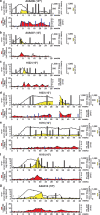The size of the viral inoculum contributes to the outcome of hepatitis B virus infection
- PMID: 19625407
- PMCID: PMC2748002
- DOI: 10.1128/JVI.00867-09
The size of the viral inoculum contributes to the outcome of hepatitis B virus infection
Abstract
The impact of virus dose on the outcome of infection is poorly understood. In this study we show that, for hepatitis B virus (HBV), the size of the inoculum contributes to the kinetics of viral spread and immunological priming, which then determine the outcome of infection. Adult chimpanzees were infected with a serially diluted monoclonal HBV inoculum. Unexpectedly, despite vastly different viral kinetics, both high-dose inocula (10(10) genome equivalents [GE] per animal) and low-dose inocula (10 degrees GE per animal) primed the CD4 T-cell response after logarithmic spread was detectable, allowing infection of 100% of hepatocytes and requiring prolonged immunopathology before clearance occurred. In contrast, intermediate (10(7) and 10(4) GE) inocula primed the T-cell response before detectable logarithmic spread and were abruptly terminated with minimal immunopathology before 0.1% of hepatocytes were infected. Surprisingly, a dosage of 10(1) GE primed the T-cell response after all hepatocytes were infected and caused either prolonged or persistent infection with severe immunopathology. Finally, CD4 T-cell depletion before inoculation of a normally rapidly controlled inoculum precluded T-cell priming and caused persistent infection with minimal immunopathology. These results suggest that the relationship between the kinetics of viral spread and CD4 T-cell priming determines the outcome of HBV infection.
Figures





References
-
- Boettler, T., E. Panther, B. Bengsch, N. Nazarova, H. C. Spangenberg, H. E. Blum, and R. Thimme. 2006. Expression of the interleukin-7 receptor alpha chain (CD127) on virus-specific CD8+ T cells identifies functionally and phenotypically defined memory T cells during acute resolving hepatitis B virus infection. J. Virol. 80:3532-3540. - PMC - PubMed
-
- Castellino, F., and R. N. Germain. 2006. Cooperation between CD4+ and CD8+ T cells: when, where, and how. Annu. Rev. Immunol. 24:519-540. - PubMed
-
- Chisari, F. V., and C. Ferrari. 1995. Hepatitis B virus immunopathogenesis. Annu. Rev. Immunol. 13:29-60. - PubMed
Publication types
MeSH terms
Substances
Grants and funding
LinkOut - more resources
Full Text Sources
Other Literature Sources
Medical
Molecular Biology Databases
Research Materials

